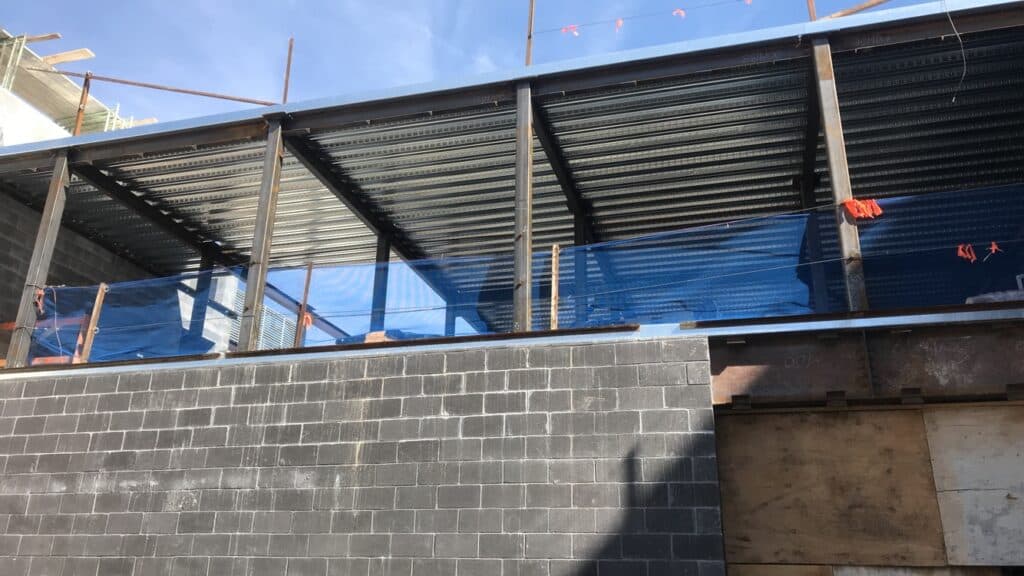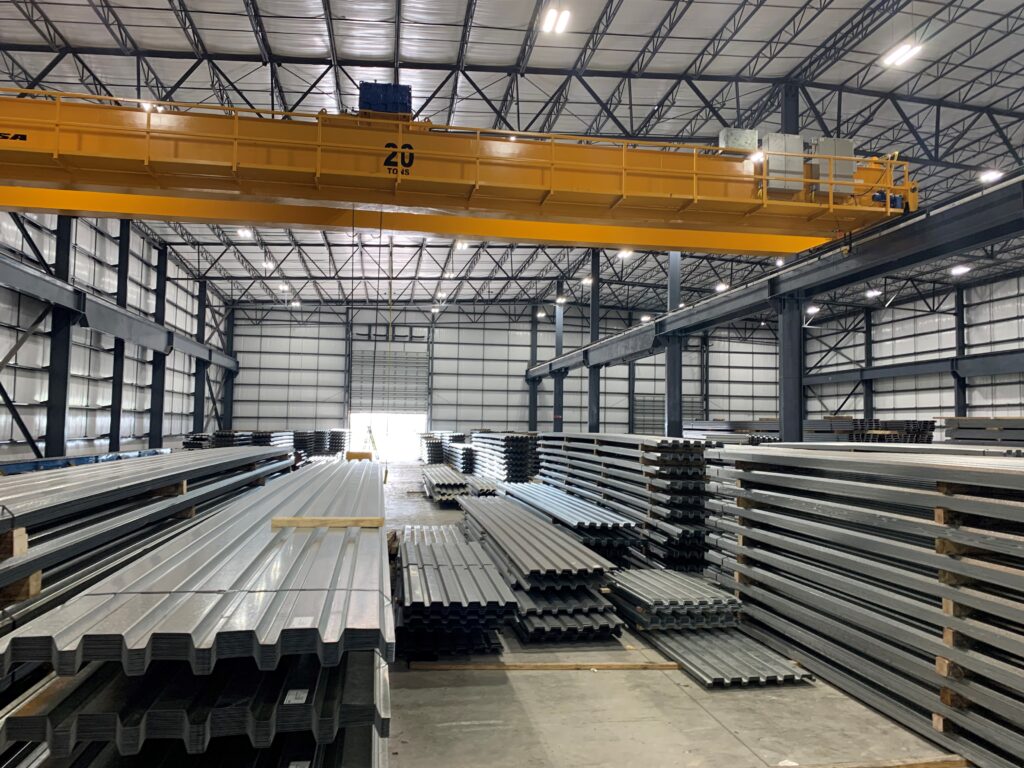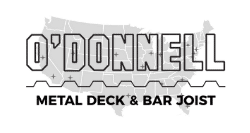
O’Donnell – Dovetail Profile Roof & Floor Deck
Vented metal decking found its original use in the 1960s due to the type of non-structural insulating concrete that was being used over it. The concrete contained perlite or vermiculite and created a gas as it cured that needed to be released in order to avoid damaging the built-up roofing above.
Today, rigid foam board is normally used on roofs, which eliminates the need for ventilation. However, there are still instances where vented metal decking is requested and still in use.
Vented Metal Decking – What is It?
Vented metal decking is either a steel roof deck or form deck that has had perforations placed in the decking during the manufacturing process to provide ventilation for specific situations.
Certain components within the roof or floor assembly, such as lightweight insulating concrete systems, might necessitate the ventilation of the steel deck to hasten the curing process. Ventilation doesn’t influence the structural integrity of the steel deck.
When not needed, the deck shouldn’t be specified as vented. The disadvantage of a vented deck is the creation of debris when concrete is poured, as the mixture seeps through the vent openings and ends up on the surface beneath.
Either cleaning this slurry or safeguarding the lower surfaces with plastic sheets incurs additional project costs without offering any benefits to the property owner when venting is unwarranted. Therefore, the need for deck ventilation should be explicitly outlined in the specifications and should be stated in the deck schedule that is included in the structural plans.
When to use Vented metal deck
If the roof or floor assembly has materials like lightweight insulating concrete, venting of the steel deck may be necessary. However, the available data does not always support the perceived value to be gained by using vented metal decking. Vented deck does not increase the strength of the structure nor is it a method of improving the air quality in the building.
Is Venting always needed?
To understand venting the deck better, let’s look at an issue a contractor might run into. If there is an exterior mezzanine that has an occupied space below, the metal deck below the concrete and the waterproofing for the mezzanine above the concrete would obviously trap slab moisture inside. This is where venting the deck is critical.
The reason for venting the deck is so that moisture from the concrete can escape through the venting. The general principle is that concrete should be allowed to breathe and should not be totally encapsulated (as would be the case if you put a non-perforated metal deck on the soffit and a waterproofing membrane on top).
When utilizing a metal deck on the soffit, it is necessary to allow for ventilation when a waterproofing membrane is applied to its upper surface. For more information, see CSA Standard S413.
The issue of venting has nothing to do with whether the waterproofing membrane leaks or not. If it leaks, you are in trouble irrespective of whether the deck is vented or not. Acoustic deck has punched holes that may be sufficient for the venting, but the juice from the concrete may come through the acoustic perforations, although that may be acceptable.
There are membrane people (such as Neoguard) who claim that their membrane is “breathable” but there are no standards for breathability, so I am not comfortable about it. A few years ago membrane manufacturers would not warrant the membrane if placed on slab on un-vented metal deck.
How Is Vented Metal Deck Manufactured?
Vents are incorporated into metal decking systems to effectively manage and eliminate excess water from lightweight insulating concrete that is typically used in non-structural roof and floor slabs. These vents appear as elongated openings or perforations and are positioned along each trough or valley of the deck.
In the context of form decks and 1.5-inch Type B roof decks, the venting area is engineered for the removal of excess liquid water, not water in vapor form. O’Donnell Metal Deck can supply venting in the deck through factory-punched integral hanger tabs, which can offer an open area of 0.25% to 0.50%.
Types of Vented Metal Deck
Slot Vented – Steel Deck Venting Process & Requirements
Step 1: Initial Verification
- If contract documents don’t specify venting percentage, the detailer should send an RFI or CCR.
- Verify that the default venting percentage is 1.5%.
- If venting is between 0.75% – 1.25%, inform production and engineering.
Step 2: Consult Fill Manufacturer
- Consult the lightweight insulation fill manufacturer for suggested venting.
Step 3: Update Bill of Material (BOM)
- Once the venting percentage is verified, indicate it in the BOM.
General Guidelines
- Default plant standard: 0.5% venting.
- Maximum venting: 1.5%.
- Recommended minimum: 0.5%.
Special Cases
NV Decking
- Max venting: 0.5% due to tooling and concrete seepage concerns.
Composite Decking
- Use integral hanger tabs for venting.
- Specify 12″ o.c. for 0.25% venting, 6″ o.c. for 0.5% venting.
- Max venting for composite deck: 0.5%.
Hangar Tabs – An Industry Perspective
The Steel Deck Institute has examined the topic of vented composite steel floor decks. The interest arises from a need to accelerate the drying time of concrete. However, there are challenges, particularly with newer adhesive formulations that are sensitive to moisture in various concrete slabs, such as slab-on-grade and suspended slabs.
- Key Focus: Accelerating concrete drying is the primary driver for vented decks.
- Challenge: Adhesive moisture sensitivity across different slab types.
Venting in Roofing Systems and Its Relevance to Floor Decks
Traditionally, venting has been a feature in steel form decks used in roofing systems. The venting allows lightweight insulating concrete (LWIC) to drain excess water and reduces vapor pressure under impermeable roofing materials. However, the impact of this venting on the properties and bonding of cured concrete in floor systems is not fully understood. Integral hanger tabs are sometimes employed for light load support and may have a secondary role in venting.
- Historical Use: Venting in roofing systems for moisture and vapor management.
- Unanswered Questions: Unclear impact of venting on concrete properties and bonding.
- Potential Solution: Integral hanger tabs for load support and possible venting.
Alternative Approaches to Moisture Management
Steel decks naturally act as vapor barriers, limiting the diffusion of water vapor from the concrete slab. For those concerned about moisture levels in slabs, there are alternative strategies for optimizing drying performance. These can include modifying the concrete mix and controlling the environmental conditions within the building.
- Natural Barrier: Steel decks function as vapor barriers.
- Alternative Methods: Multiple strategies for moisture control in concrete slabs.
Integral Hanger Tabs and Their Impact on Venting
Integral hanger tabs are primarily used for supporting light loads in composite decks. While they do introduce some open areas in the decking, their primary purpose is not venting. Current data and industry experience suggest that the open areas created by these tabs have a minimal impact on the drying rate of concrete and its bonding with the steel deck.
- Primary Function: Load support, not venting.
- Minimal Impact: Negligible effect on concrete drying rates.
This comprehensive look at vented composite steel floor decks provides valuable insights for industry professionals interested in moisture management solutions.
Venting May Help with Floor Coverings
Newer formulations of adhesives for floor coverings installed over concrete and metal deck slabs have been causing problems in recent years. The adhesives appear to be more sensitive to moisture levels in the slab. Therefore, it is sometimes recommended that floor decks be vented to allow water vapor to escape.
This is thought to improve the performance of the adhesives.
Why Choose O’Donnell Metal Deck?

O’Donnell Metal Deck – Metal Roof Decking
O’Donnell Metal Deck, a leader in the industry, provides high-quality metal decks for both residential and commercial applications. Our roof and form decks are designed and manufactured following the highest industry standards for unmatched quality and durability. We understand the specific requirements of different construction projects and offer tailored solutions that best meet your needs.
Contact us today for more information!





